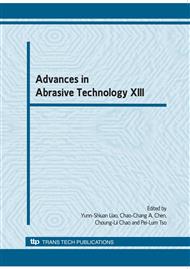p.423
p.429
p.435
p.441
p.447
p.457
p.463
p.469
p.475
Study the Rheological Properties of Abrasive Gel with Various Passageways in Abrasive Flow Machining
Abstract:
Abrasive flow machining (AFM) is a simple and efficient method to remove recasting layers making by wire electrical discharge machining (WEDM). However, conventional AFM methods have difficulty achieving uniform roughness of an axial distribution in circular hole polishing due to limited unitary axial motion of abrasive media. Therefore, this work develops mechanism designs for different passageways to obtain multiple flowing paths of abrasive medium, whose flowing behavior enhances polishing effectiveness by increasing the abrasive surface area and radial shear forces. The motion of the abrasive medium is studied by utilizing different mold cores, which mold shapes include the circular, hollow and helical passageway. The optimum design of the passageways is then verified using CFD-ACE+ software, numerical results indicate that passageway with six helices performed better in the uniform surface roughness than others’ do. Experimental results show that roughness deviation of six helices passageway of approximately 0.100 m Ra is significantly better than those on a circular passageway of around 0.1760 m Ra. Additionally, the six helices passageway is also superior to circular passageway in reducing roughness improvement rate (RIR) by roughly 87% compared with RIR 67.7% for the circular passageway.
Info:
Periodical:
Pages:
447-456
Citation:
Online since:
August 2010
Authors:
Price:
Сopyright:
© 2010 Trans Tech Publications Ltd. All Rights Reserved
Share:
Citation:


